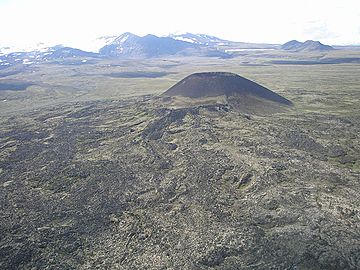Eve Cone facts for kids
Quick facts for kids Eve Cone |
|
|---|---|

Eve Cone
|
|
| Highest point | |
| Elevation | 1,702 m (5,584 ft) |
| Prominence | 172 m (564 ft) |
| Geography | |
| Location | Stikine Country, British Columbia, Canada |
| Parent range | Tahltan Highland (southwestern Stikine Plateau) |
| Topo map | NTS 104G/15 |
| Geology | |
| Age of rock | Holocene |
| Mountain type | Cinder cone |
| Volcanic arc/belt | Northern Cordilleran Volcanic Province |
| Last eruption | 700 |
Eve Cone is a special type of volcano called a cinder cone. It is found in a place called the Big Raven Plateau in British Columbia, Canada. This cone is very well-preserved and looks like a perfect black cone.
Eve Cone is one of about 30 cinder cones that grew on the sides of a much larger volcano called Mount Edziza. It formed around the year 700. This makes it one of the newest volcanoes to erupt in this area of Canada. Eve Cone stands out in the middle of the Desolation Lava Field. Its unique shape can be seen from far away. People often take pictures of it. The cone is covered by light yellow pumice, which is a type of light volcanic rock. This pumice came from a nearby, but unknown, volcanic vent.
Contents
What is a Cinder Cone?
A cinder cone is the simplest type of volcano. It is shaped like a cone, similar to a hill. These volcanoes are built from bits of hardened lava and ash. These bits are called "cinders" or "scoria."
How Cinder Cones Form
Cinder cones form when gas-rich lava erupts explosively from a single vent. The lava breaks into small pieces as it flies into the air. These pieces cool quickly and fall back to the ground around the vent. Over time, these cinders pile up to create the cone shape. The cone usually has a bowl-shaped crater at its top.
Features of Cinder Cones
- Cinder cones are often quite small compared to other volcanoes.
- They usually erupt only once or for a short period.
- Their sides are typically steep, often around 30 to 40 degrees.
- The cinders are usually dark, giving the cone a black or reddish-brown color.
Eve Cone's Location and Surroundings
Eve Cone is located in a wild and beautiful part of British Columbia. This area is known for its many volcanoes. It sits on the Big Raven Plateau, which is part of the larger Stikine Plateau.
The Desolation Lava Field
Eve Cone stands alone in the middle of the Desolation Lava Field. This field is a large area covered by hardened lava flows. Imagine a landscape where molten rock once flowed like a river and then cooled into solid ground. This makes the area around Eve Cone look very unique and rugged.
Part of a Bigger Volcano
Eve Cone is not alone in its volcanic neighborhood. It is part of the Mount Edziza volcanic complex. Mount Edziza is a huge shield volcano. Shield volcanoes are very wide and have gentle slopes, like a warrior's shield lying on the ground. They are built up by many flows of very fluid lava. Eve Cone and the other cinder cones are like smaller bumps on the sides of this giant shield volcano.
Eve Cone's Age and History
Eve Cone is considered a very young volcano in geological terms. It formed during the Holocene epoch. The Holocene epoch is the current geological time period, which began about 11,700 years ago.
A Recent Eruption
Scientists believe Eve Cone erupted around the year 700. This makes it one of the most recent volcanic eruptions in the Big Raven Plateau. It's quite amazing to think that this cone formed when many parts of the world were still in early medieval times! The eruption was likely short but powerful, creating the cone we see today.
The Pumice Cover
The light yellow pumice covering Eve Cone is interesting. Pumice is a very light and porous volcanic rock. It forms when gas-rich lava cools very quickly. The pumice on Eve Cone suggests that another explosive eruption happened nearby. This eruption covered Eve Cone with a layer of this light, frothy rock.
Why Eve Cone is Important
Eve Cone is important for several reasons.
- Well-Preserved: Its shape is still very clear and hasn't been worn down much by weather. This makes it a great example of a cinder cone.
- Recent Activity: It shows that the Mount Edziza area has been volcanically active quite recently. This helps scientists understand the history of volcanoes in Canada.
- Distinctive Landmark: Its unique shape makes it a recognizable feature in the landscape. It's a popular spot for photographers.
Studying volcanoes like Eve Cone helps scientists learn more about how our Earth works. It teaches us about the powerful forces deep beneath the surface that shape our planet.

